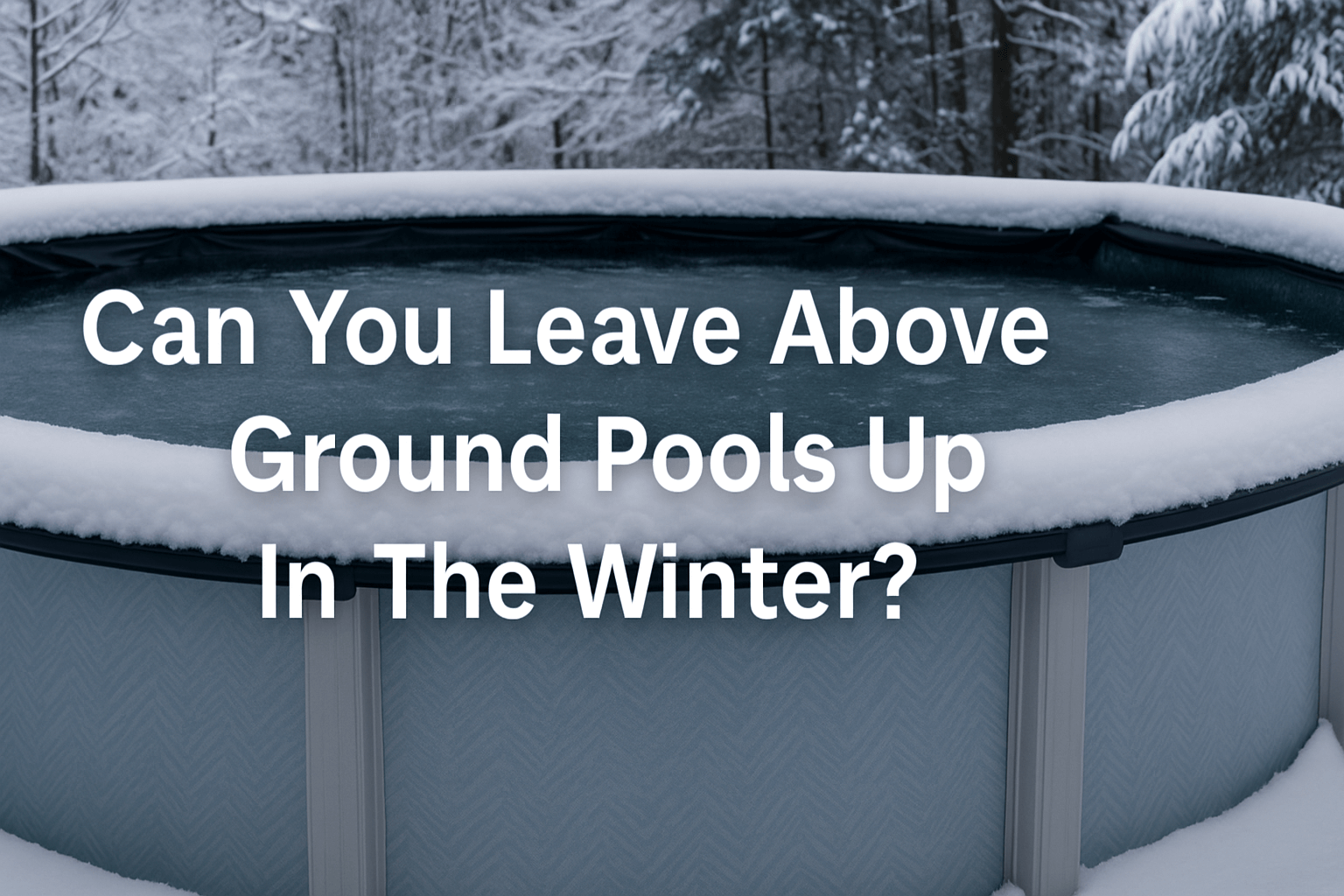
Can You Leave Above Ground Pools Up In The Winter?
Can you leave above ground pools up in the winter? Yes—but only if you winterise them properly. Otherwise, you're basically handing Jack Frost a giant frozen paddling pool.
In this guide, we’ll show you how to keep even the best above ground pools protected through the chilly season—and how to avoid waking up to a cracked liner and a sky-high repair bill come spring.
Why Leaving Pools Up is Often Recommended
Avoiding Wear and Tear from Disassembly and Reassembly
Let’s be honest—taking down an above ground pool isn’t exactly a Sunday afternoon project.
The constant assembling and dismantling can wear out seals, frames, and liners quicker than you'd expect. We’ve heard from one parent who swore they'd never take their pool down again after a bent frame and a missing bolt turned their spring setup into a full-day drama.
Leaving it up avoids all that faff.
Saving Time, Effort, and Storage Space
Think about it—where are you even supposed to store a 12ft liner? Or a metal frame?
Keeping your pool up means no wrestling with giant plastic bags, no losing parts, and no trying to fold something that clearly was never meant to be folded.
Plus, when the first warm weekend hits, you're ready to go.
Maintaining Ground Stability Under the Pool
Taking your pool down can affect the stability of the base beneath it. Rain, frost, and the freeze-thaw cycle can mess with your level ground, leading to dips or slants by spring.
Leave it in place, and everything stays settled—no need to relevel before filling.
Cost-Effectiveness Compared to Repairs from Improper Storage
Improperly stored parts can crack, warp or rust. And no one wants to pay for a new liner just because it was folded wrong or sat damp all winter.
Leaving it up—covered and winterised—can save you from shelling out hundreds on replacement parts before the season even starts.

Types of Above Ground Pools Suitable for Winter
Hard-Sided Pools (Steel Wall, Aluminium Wall, Resin Frame)
Designed for Year-Round Durability
Hard-sided pools are built tough. Think of them like the 4x4s of the pool world—sturdy, rugged, and ready for whatever winter throws at them.
Many are designed to be left up all year, as long as you winterise them correctly.
Importance of Corrosion-Resistant Materials and Coatings
Look out for pools with rust-resistant finishes or resin-coated frames. These materials handle wet UK winters far better than untreated steel.
If you’re buying new, it’s worth investing in one that’s made with longevity in mind.
Soft-Sided Frame Pools (Often Can Stay Up, But Check Manufacturer)
Soft-sided pools can be left up in some cases—but always check the manufacturer’s guide first.
Some models cope well with a cold snap. Others? Not so much.
One customer we spoke to left theirs up without checking, only to find it sagging and cracked by February. Moral of the story: read the label.
Pools Typically Taken Down for Winter
Inflatable or "Easy Set" Pools
Inflatable pools aren’t made for frost. The vinyl becomes brittle, and one icy night can be enough to cause a tear or a slow, frustrating leak come spring.
If your pool inflates, deflate it and store it somewhere dry.
Smaller, Less Durable Frame Pools
Smaller, low-cost pools often aren’t designed to survive winter outdoors. The metal can rust, the liner can split, and the frame might not stand up to wind or heavy rain.
Best to play it safe—take it down, dry it out, and store it properly.
When Disassembly is Simpler Than Winterisation
If your pool is small, light, and quick to pack up, winterisation may be more effort than it’s worth.
In these cases, taking it down is often the quicker, safer route.

Do You Take Down Above Ground Pools in the Winter? The Winterisation Process
The Critical Need for Winterisation
Preventing Freeze Damage to Pool Structure and Equipment
Liner Tears, Wall Buckling, Burst Pipes
Water expands when it freezes—and that’s bad news if your pool isn’t prepped.
We’ve seen liners split like wrapping paper and rigid walls buckle from trapped ice. Pipes and fittings? They can burst clean open if water’s left inside.
Winterising is your insurance policy against all of that.
Damage to Pumps, Filters, and Heaters
Pump motors and filters don’t cope well with frost. One customer skipped the draining step, and by spring their filter system looked like it had exploded.
It only takes one cold night to do real damage.
Preventing Algae Growth and Staining
Even in winter, algae can grow if the chemistry’s off.
Fail to clean and treat your water and you might reopen to a murky green swamp. Getting rid of stains on the liner can be a nightmare—prevention is way easier.
Key Steps for Winterising an Above Ground Pool
Thorough Cleaning and Chemical Balancing
Start by removing leaves, dirt, and debris. Anything left behind can stain or throw off your water chemistry.
Then balance your chlorine, pH, and alkalinity levels. Add winterising chemicals if needed.
Clean water in = clean water out.
Lowering the Water Level (Below Skimmer/Return Jets)
Lower the water level so it sits just under the skimmer or return jets.
This prevents ice from damaging pipes or fittings. Don’t drain it completely—the water helps support the pool walls over winter.
Draining and Storing All Plumbing and Equipment
Drain out pumps, filters, and hoses. Then store them somewhere dry and frost-free—like a shed or utility room.
Make sure everything is dry to prevent mould or rust.
Using an Air Pillow to Absorb Ice Expansion
Pop an air pillow (or a large inflatable ring) in the centre of the pool before covering it.
It helps absorb pressure from ice expansion and prevents the pool walls from taking the strain. It’s a small step with big benefits.
Installing a Secure Winter Cover
Finish with a good quality winter cover. Make sure it’s tight, secure, and built to handle rain, wind, and snow.
Use clips or a cable system to keep it from blowing off in a storm.

Risks of Not Winterising or Taking Down
Costly Repairs and Replacements
Skip winterisation, and you could be looking at split liners, rusted frames, or broken equipment.
We’ve seen people spend more on repairs than they paid for the pool itself. Don’t be that person.
Difficult and Time-Consuming Spring Opening
A winter’s worth of leaves, green water, and damaged kit? That’s not the way you want to start pool season.
Proper winter prep makes spring setup a breeze.
Potential Voiding of Manufacturer Warranties
Many pool warranties have fine print that requires winterisation. If you don’t follow the steps, you may be on your own if something goes wrong.
Always read the manual—and keep receipts and photos if you're claiming later.
Ready to winter-proof your pool?
Whether you’ve got a rugged resin-sided giant or a compact weekend splash pool, the right winterisation steps can save time, money, and sanity.
It’s not just about protection—it’s about getting straight to the fun when the sun comes back out.
Have you checked out our other posts?
Will Above Ground Pool Freeze?
Do You Drain Above Ground Pools In The Winter?
Do You Empty An Above-Ground Pool Every Year?



Leave a comment